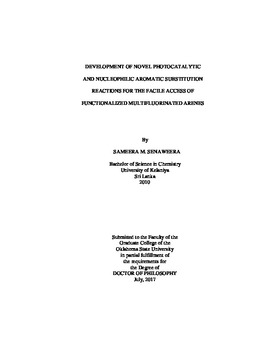| dc.contributor.advisor | Weaver, Jimmie D. | |
| dc.contributor.author | Senaweera, Sameera M. | |
| dc.date.accessioned | 2018-04-23T19:36:10Z | |
| dc.date.available | 2018-04-23T19:36:10Z | |
| dc.date.issued | 2017-07 | |
| dc.identifier.uri | https://hdl.handle.net/11244/299545 | |
| dc.description.abstract | Functionalized multifluorinated arenes are an important class of molecules, because the incorporation of fluorine can alter or enhance the properties of a molecule. Since there have been no naturally occurring fluoroaromatics identified, all the aryl fluorides must be synthesized. While the selective installation of fluorines to synthesize multifluoroarenes is challenging, perfluoroarenes and heteroarenes can be produced industrially on scale, and represent an ideal starting point for the synthesis of multifluorinated arenes. However, due to the short and strong nature of the C-F bond, subsequent functionalization is challenging. As a part of the C-F functionalization program in the Weaver lab, the work presented in this dissertation is focused on development novel methodologies to access functionalized, partially fluorinated aromatics. In this approach, the goal is to selectively remove or functionalize the undesired fluorines of perfluoroarenes while keeping the desired fluorines intact. In this vein, we have shown that a key perfluoroaryl radical intermediate can be formed via photocatalytic electron transfer and can be selectively functionalized. The possibility for this radical to undergo facile reduction and arylation is discussed. The development of these methods has rapidly expanded the synthetic possibilities of multifluorinated arenes and has outpaced the availability of more complex polyfluoroaryl starting materials. In order to circumvent low availability of functionalized fluoroaryl building blocks, nucleophilic aromatic substitutions (SNAr) with fluoroarenes have also been explored. One example is the addition of Meldrum's acid to polyfluoroarenes which generates a novel class of compounds that can serve as a synthon for a-perfluoroaryl acetic acids. Some nucleophilic additions require extreme conditions which severely limits their utility. To overcome the inherent difficulties associated with chlorodefluorination, a catalyst was developed in which an aromatic donor-acceptor interaction was identified as a key feature. This catalyst facilitated the development of a mild method for the chlorodefluorination of perfluoroarenes. The synergistic use of photocatalysis and SNAr chemistry is an expedient way to access functionalized polyfluoroaromatics and is also discussed in this dissertation. | |
| dc.format | application/pdf | |
| dc.language | en_US | |
| dc.rights | Copyright is held by the author who has granted the Oklahoma State University Library the non-exclusive right to share this material in its institutional repository. Contact Digital Library Services at lib-dls@okstate.edu or 405-744-9161 for the permission policy on the use, reproduction or distribution of this material. | |
| dc.title | Development of novel photocatalytic and nucleophilic aromatic substitution reactions for the facile access of functionalized multifluorinated arenes | |
| dc.contributor.committeeMember | Bunce, Richard A. | |
| dc.contributor.committeeMember | Rahaim, Ronald J. | |
| dc.contributor.committeeMember | Fennell, Christopher | |
| dc.contributor.committeeMember | Shaw, Jennifer H. | |
| osu.filename | Senaweera_okstate_0664D_15349.pdf | |
| osu.accesstype | Open Access | |
| dc.type.genre | Dissertation | |
| dc.type.material | Text | |
| thesis.degree.discipline | Chemistry | |
| thesis.degree.grantor | Oklahoma State University | |
